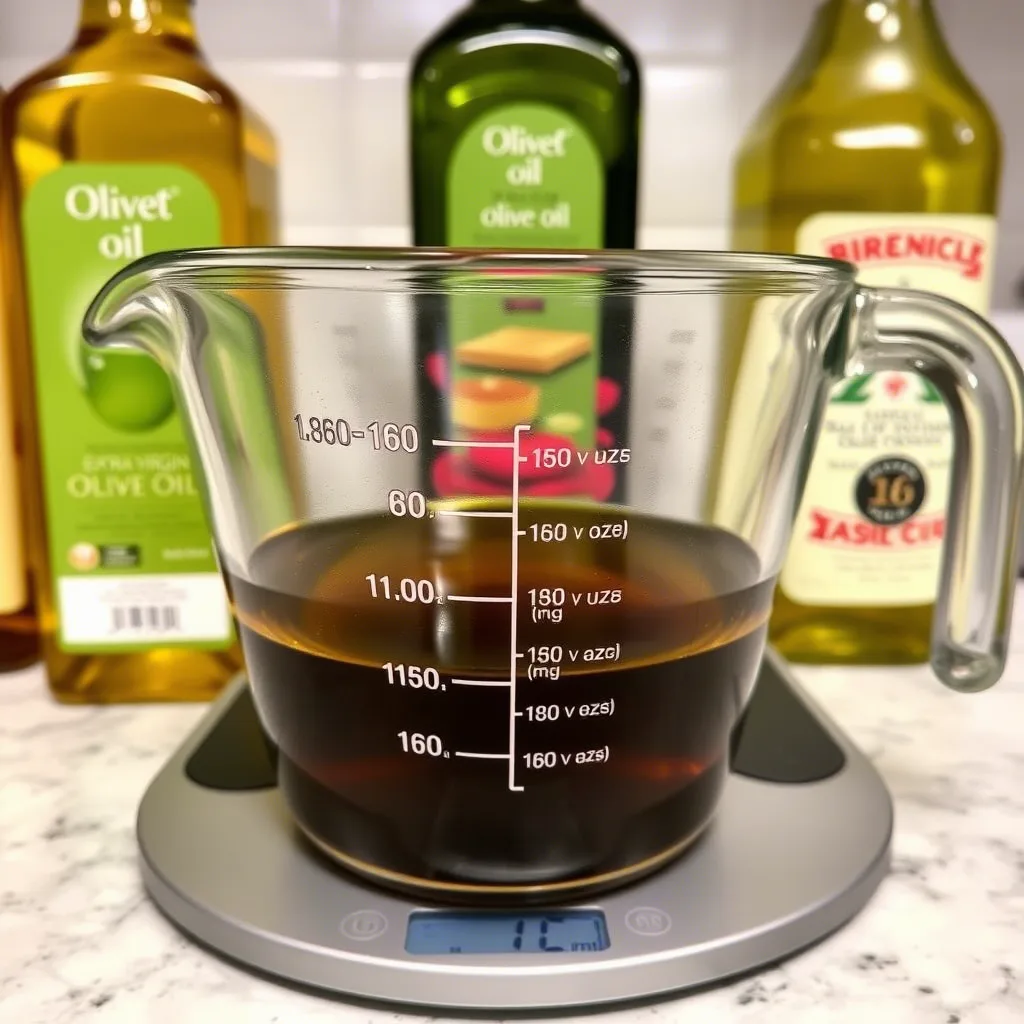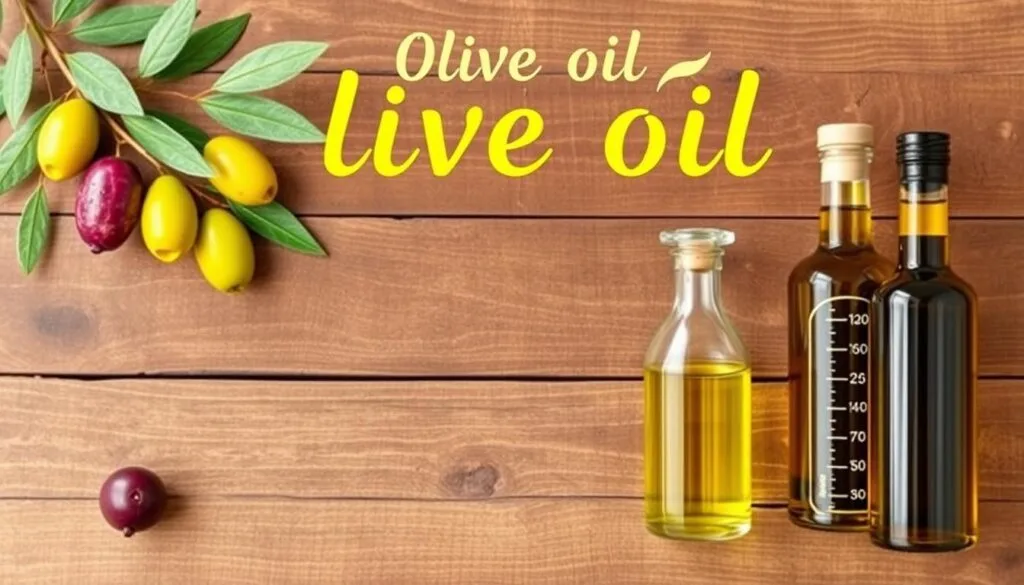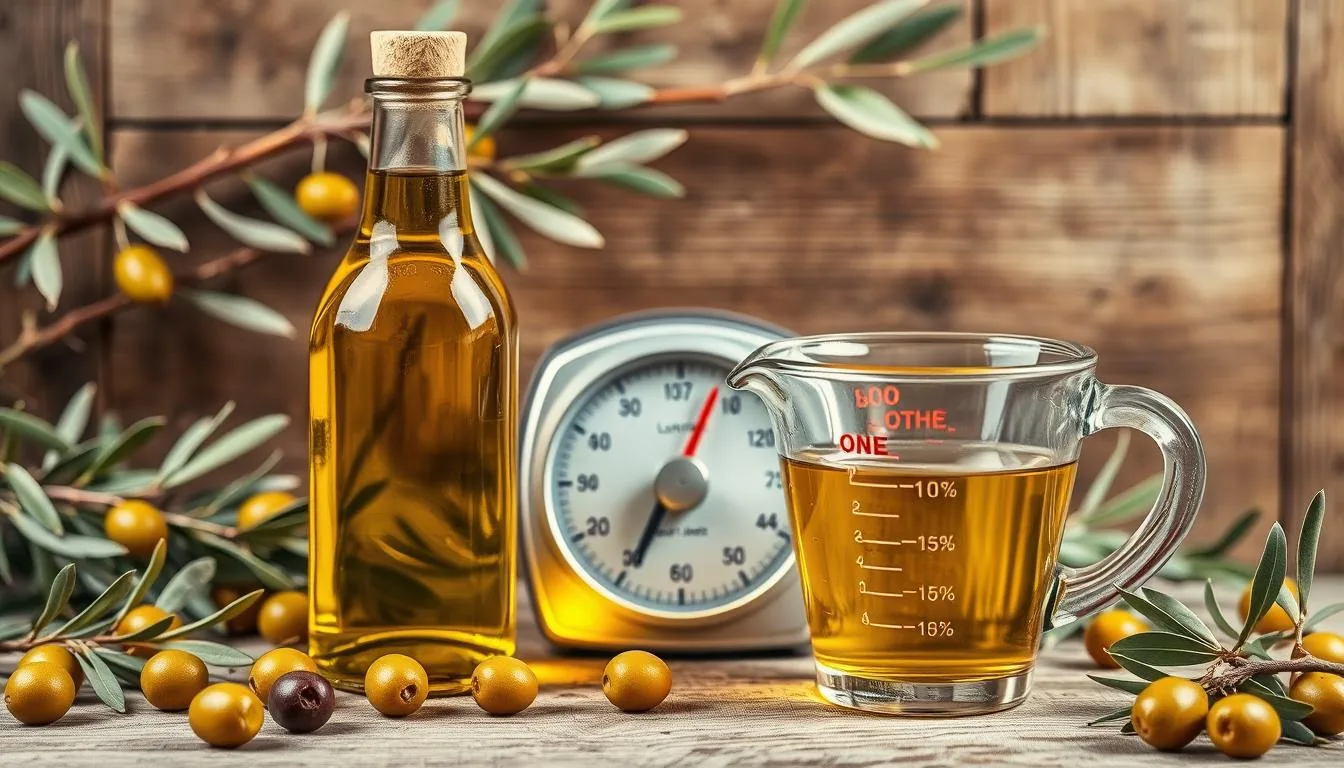When it comes to cooking and baking, accurate measurements are crucial for achieving the perfect dish. One common question that arises is how many fluid ounces in one pound of olive oil. Understanding olive oil weight conversion is essential for any home cook or professional chef. In this article, we will delve into the world of olive oil measurements, providing a comprehensive guide on converting pounds to fluid ounces.
Accurate measurements are vital in the kitchen, and olive oil is no exception. Knowing how many fluid ounces in one pound of olive oil can make all the difference in your recipes. With this knowledge, you’ll be able to convert between weight and volume with ease, ensuring your dishes turn out perfectly every time.
Key Takeaways
- Understanding olive oil weight conversion is crucial for accurate measurements
- Knowing how many fluid ounces in one pound of olive oil is essential for cooking and baking
- Accurate measurements can make a significant difference in the outcome of your recipes
- Olive oil weight conversion is a vital skill for home cooks and professional chefs alike
- Converting between weight and volume can be easy with the right knowledge and tools
- How many fluid ounces in one pound of olive oil is a common question with a simple answer
- Olive oil weight conversion is a fundamental aspect of cooking and baking with olive oil
Understanding Olive Oil Measurements Basics
When it comes to measuring olive oil, it’s essential to understand the difference between weight and volume measurements. This distinction is crucial because olive oil is measured differently than other liquids. To accurately measure olive oil, you need to consider its density, which affects the conversion between weight and volume. For instance, when converting olive oil pound to fluid ounces, you must take into account the liquid’s density to get an accurate measurement.
The process of olive oil liquid measurement can be complex, but it’s vital for achieving the perfect flavor and texture in your recipes. To simplify this process, it’s helpful to know the common measurement units used for olive oil, including pounds, fluid ounces, and milliliters. By understanding these units and how to convert between them, you can ensure that your dishes turn out as intended.
Weight vs. Volume Measurements
In the context of olive oil, weight measurements are often more accurate than volume measurements. This is because the density of olive oil can vary depending on factors like temperature and the specific type of oil. When measuring olive oil by weight, you can use a scale to get a precise measurement. On the other hand, volume measurements can be less accurate due to the potential for variation in the oil’s density.
Why Olive Oil is Measured Differently
Olive oil is measured differently than other liquids due to its unique properties. The density of olive oil is typically around 0.92 g/cm³, which is slightly less than that of water. This means that a given volume of olive oil will weigh less than the same volume of water. As a result, recipes that call for olive oil often specify the amount in terms of weight rather than volume to ensure accuracy.
Common Measurement Units for Olive Oil
Some common measurement units for olive oil include:
- Pounds (lb)
- Fluid ounces (fl oz)
- Milliliters (mL)
By understanding these units and how to convert between them, you can simplify the process of measuring olive oil and ensure that your recipes turn out as intended. Whether you’re converting olive oil pound to fluid ounces or measuring the oil in milliliters, it’s essential to consider the oil’s density and the specific requirements of your recipe.
How Many Fluid Ounces in One Pound of Olive Oil
To determine the number of fluid ounces in one pound of olive oil, it’s essential to understand the conversion process. The conversion of olive oil pounds to fluid ounces is crucial in cooking and recipe preparation. When looking to convert olive oil pounds to fluid ounces, it’s vital to consider the density of olive oil, which is approximately 0.92 g/ml.
The fluid ounces in olive oil pound conversion can be calculated using a simple formula. Since 1 pound is equal to 16 ounces, and 1 fluid ounce of olive oil is approximately equal to 0.92 ounces (by weight), we can calculate the number of fluid ounces in one pound of olive oil. This calculation yields approximately 16 / 0.92 = 17.39 fluid ounces in one pound of olive oil.
Here are the key points to consider when converting olive oil pounds to fluid ounces:
- 1 pound of olive oil is approximately equal to 17.39 fluid ounces
- The density of olive oil is approximately 0.92 g/ml
- Fluid ounces in olive oil pound conversion is essential for accurate recipe preparation
By understanding the conversion process and using the correct calculations, you can easily convert olive oil pounds to fluid ounces and ensure accurate measurements in your cooking and recipes.
The Science Behind Olive Oil Density
To understand how to calculate olive oil measurements, it’s essential to delve into the science behind olive oil density. This knowledge will help you create an accurate olive oil conversion chart. Olive oil density is affected by its specific gravity, which is the ratio of the density of olive oil to the density of water. The specific gravity of olive oil is typically around 0.918, but it can vary depending on the type of olive oil and its temperature.
Factors Affecting Olive Oil Density
Several factors can affect the density of olive oil, including temperature and the type of olives used to produce the oil. For example, extra virgin olive oil tends to have a higher density than pure olive oil due to its higher acidity level and lower processing temperature. Understanding these factors is crucial when learning how to calculate olive oil measurements and creating an olive oil conversion chart.

Different Types of Olive Oil and Their Densities
Here are some common types of olive oil and their respective densities:
- Extra Virgin Olive Oil: 0.922-0.926 g/cm³
- Virgin Olive Oil: 0.920-0.924 g/cm³
- Pure Olive Oil: 0.916-0.920 g/cm³
These values can vary depending on the specific production methods and ingredients used. By considering these factors and using an olive oil conversion chart, you can ensure accurate measurements in your recipes.
Converting Between Weight and Volume for Olive Oil
When working with olive oil, it’s essential to understand how to convert between weight and volume measurements. This is because recipes often require specific amounts of olive oil, and using the wrong measurement can affect the final result. To perform an olive oil weight conversion, you can use a conversion chart or formula.
A common conversion is from pounds to fluid ounces. For example, one pound of olive oil is approximately equal to 16 fluid ounces. This is important to know when following a recipe that requires a specific amount of olive oil liquid measurement. You can also use online tools or apps to make conversions easier and more accurate.
To make conversions simpler, here are some common conversions to keep in mind:
- 1 pound = 16 fluid ounces
- 1 fluid ounce = 29.6 milliliters
- 1 cup = 8 fluid ounces
By understanding how to convert between weight and volume for olive oil, you can ensure that your recipes turn out as intended. Whether you’re a professional chef or a home cook, accurateolive oil weight conversionandolive oil liquid measurementare crucial for achieving the best results.
Practical Kitchen Conversion Tips for Olive Oil
When working with olive oil in the kitchen, accurate measurements are crucial for achieving the desired flavor and texture in dishes. Understanding how many fluid ounces in one pound of olive oil is essential for conversions. To convert olive oil pound to fluid ounces, it’s helpful to know that the density of olive oil can vary, but a general guideline is that one pound of olive oil is approximately equal to 16 fluid ounces.
In practical terms, this means that when a recipe calls for a certain amount of olive oil in pounds, you can easily convert it to fluid ounces. For instance, if a recipe requires 0.5 pounds of olive oil, you would need about 8 fluid ounces. This conversion is straightforward once you know the ratio of olive oil pound to fluid ounces.
Common Cooking Measurements
Cooking with olive oil often involves using standard kitchen measurements such as tablespoons, teaspoons, and cups. Knowing how these measurements relate to fluid ounces is helpful. For example, 1 cup is equal to 8 fluid ounces, and 1 tablespoon is equal to about 0.5 fluid ounces. These conversions are essential for accurately measuring olive oil in recipes.
Kitchen Tools for Accurate Measurement
Using the right kitchen tools can make measuring olive oil much easier and more accurate. Digital kitchen scales are highly recommended for measuring ingredients by weight, including olive oil. Additionally, measuring cups and spoons specifically designed for liquids can help in converting olive oil pound to fluid ounces accurately.
Common Mistakes in Olive Oil Measurement
When it comes to measuring olive oil, accuracy is crucial for achieving the desired flavor and texture in cooking and baking. One common mistake is using an incorrect olive oil conversion chart, which can lead to inconsistent results. For instance, not knowing the exact number of fluid ounces in olive oil pound conversion can affect the overall quality of the dish.
To avoid such mistakes, it’s essential to understand the basics of olive oil measurement. Here are some tips to keep in mind:
- Always use a digital scale to measure olive oil by weight, as it’s more accurate than measuring by volume.
- Use an olive oil conversion chart to convert between weight and volume measurements.
- Be aware of the different densities of various olive oil types, as this can affect the fluid ounces in olive oil pound conversion.
By following these tips and using the right measurement tools, you can ensure accurate olive oil measurements and achieve the best results in your cooking and baking. Remember, precision is key when working with ingredients like olive oil, and using the right olive oil conversion chart can make all the difference.
With practice and attention to detail, you can master the art of measuring olive oil and take your cooking to the next level. Whether you’re a professional chef or a home cook, accurate measurements are essential for creating delicious and consistent dishes.
Digital Tools and Apps for Olive Oil Conversion
When it comes to how to calculate olive oil measurements, having the right digital tools can make a significant difference. With the rise of technology, there are now numerous apps and online resources available to help with olive oil weight conversion. These tools can save time and reduce errors, making them essential for anyone who works with olive oil regularly.
In today’s digital age, it’s easier than ever to find reliable conversion tools. Many websites offer olive oil weight conversion calculators, which can be used to convert between different units of measurement. Additionally, there are several mobile apps available that can be used to calculate olive oil measurements on-the-go.
Recommended Conversion Applications
Some popular apps for olive oil weight conversion include:
- Olive Oil Converter: This app allows users to convert between different units of measurement, including fluid ounces, milliliters, and pounds.
- Cooking Converter: This app offers a range of conversion tools, including an olive oil weight conversion calculator.
- Unit Converter: This app provides a comprehensive range of conversion tools, including how to calculate olive oil measurements.
Online Calculators and Resources
In addition to mobile apps, there are also many online resources available for olive oil weight conversion. Some popular websites include:
- Olive Oil Calculator: This website offers a range of conversion tools, including an olive oil weight conversion calculator.
- Cooking Website: This website provides a range of cooking resources, including an olive oil weight conversion calculator.
By using these digital tools and apps, individuals can easily calculate olive oil measurements and convert between different units of measurement. This can help to reduce errors and make cooking with olive oil easier and more efficient.
Regional Differences in Olive Oil Measurements
When it comes to measuring olive oil, different regions have their own unique methods and standards. Understanding these regional differences is crucial for accurate olive oil liquid measurement and conversion, including olive oil pound to fluid ounces. In the United States, for example, recipes often call for olive oil in cups or fluid ounces, while in Europe, milliliters or liters are more commonly used.
The use of US and metric measurements can sometimes lead to confusion, especially when converting between the two systems. To avoid errors, it’s essential to understand the equivalent measurements, such as 1 cup being equal to 8 fluid ounces or 237 milliliters. This knowledge will help you to accurately measure olive oil, whether you’re using a recipe from the US or abroad.
US vs. Metric Measurements
In international cooking, standards can vary greatly. Some countries, like Australia and Canada, use a combination of US and metric measurements, while others, like the UK, use a mix of imperial and metric systems. To navigate these differences, it’s helpful to have a basic understanding of both systems and be able to convert between them. For instance, knowing that 1 pound of olive oil is approximately equal to 16 fluid ounces or 473 milliliters can be very useful.
International Cooking Standards
Despite these regional differences, there are some international cooking standards that can help simplify olive oil measurement. Many professional chefs and cookbook authors use a standardized system of measurement, such as the metric system, to ensure accuracy and consistency. By following these standards and using the right conversion tools, home cooks and professional chefs alike can ensure that their olive oil measurements are accurate, whether they’re using olive oil pound to fluid ounces or other units of measurement.
Professional Culinary Standards for Olive Oil Measurement
In commercial kitchens, accurate measurements are crucial for producing high-quality dishes. When it comes to olive oil, professional chefs rely on standardized measurements to ensure consistency and flavor. To determine how many fluid ounces in one pound of olive oil, chefs use an olive oil conversion chart to guide their measurements.
Some key considerations for professional culinary standards include:
- Using high-quality olive oil that meets international standards
- Investing in accurate kitchen tools, such as digital scales and measuring cups
- Developing a thorough understanding of olive oil conversion chart to facilitate easy conversions
By following these standards, professional chefs can ensure that their dishes are consistently flavorful and of high quality. Whether you’re a seasoned chef or an aspiring cook, understanding how many fluid ounces in one pound of olive oil is essential for producing exceptional culinary creations.

Conclusion
In this comprehensive guide, we’ve explored the intricacies of measuring olive oil by weight and volume, unlocking the secrets to accurate conversions. From understanding the science behind olive oil density to discovering practical kitchen tips, you now possess the knowledge to elevate your culinary experiences.
Precise fluid ounces in olive oil pound conversion and olive oil weight conversion skills are essential for any home cook or professional chef. By mastering these techniques, you can ensure consistent results in your recipes, whether you’re baking, sautéing, or drizzling the perfect finishing touch.
Remember, accurate measurements are the foundation of culinary success. Embrace the tools and resources highlighted in this article, and continually refine your olive oil measurement expertise. With dedication and practice, you’ll soon be recognized as a true master of the kitchen, delivering exceptional dishes every time.
FAQ
How many fluid ounces are in one pound of olive oil?
One pound of olive oil is equivalent to approximately 24 fluid ounces.
What is the difference between weight and volume measurements for olive oil?
Olive oil is measured differently than other liquids because it has a unique density. Weight measurements, such as pounds, are used to measure the mass of olive oil, while volume measurements, such as fluid ounces, are used to measure the amount of space the oil occupies.
What are the common measurement units for olive oil?
The common measurement units for olive oil include pounds, fluid ounces, and milliliters. These units are used to measure both the weight and volume of olive oil.
How does the specific gravity of olive oil affect conversions?
The specific gravity of olive oil, which is the ratio of the density of the oil to the density of water, affects how it converts between weight and volume measurements. Different types of olive oil, such as extra virgin, virgin, and pure, have slightly different densities, which can impact the conversion process.
What are some common mistakes in measuring olive oil?
Common mistakes in measuring olive oil include using the wrong conversion factors, inaccurately reading measurement marks on containers, and failing to account for temperature changes that can affect the oil’s density.
What digital tools and apps are available for olive oil conversions?
There are various digital tools and apps available for olive oil conversions, including online calculators, mobile apps, and conversion charts. These resources can help ensure accurate measurements and reduce the risk of conversion errors.
How do olive oil measurements differ between the US and other countries?
Olive oil measurements can vary between the US and other countries due to differences in cooking standards and the use of US customary or metric units. It’s important to be aware of these regional differences when working with olive oil recipes from different parts of the world.
What are the professional culinary standards for olive oil measurement?
In professional kitchens, accurate olive oil measurement is crucial for consistent recipe execution and quality control. Chefs and restaurants often use specialized equipment and adhere to strict measurement protocols to ensure precise olive oil measurements.
